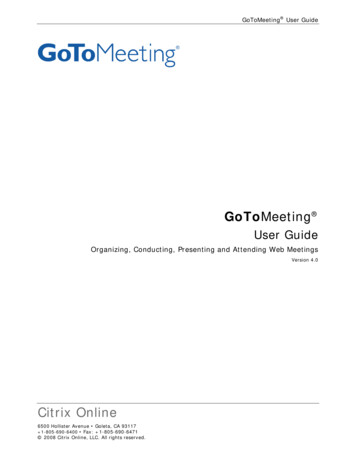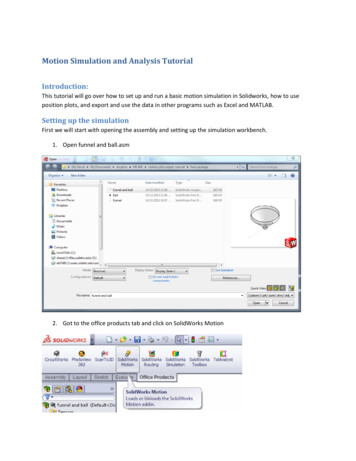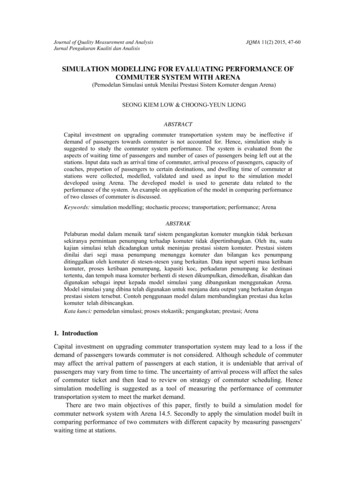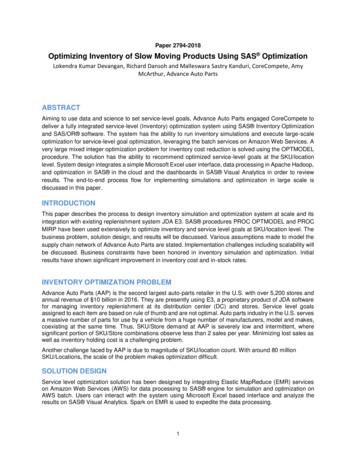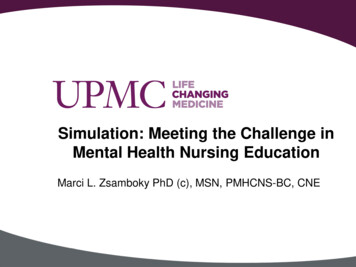
Transcription
Simulation: Meeting the Challenge inMental Health Nursing EducationMarci L. Zsamboky PhD (c), MSN, PMHCNS-BC, CNE
Educational Objectives The participant will understand effective scenariodevelopment in mental health nursing simulation Scenario development Standardized patient training Developing objectives for mental health simulation The participant will distinguish methods for debriefingstudents in mental health nursing simulation Areas for debriefing Student reflection on QSEN competencies2
Introductions UPMC Shadyside School of Nursing Affiliated with University of Pittsburgh Medical Center 289 Students Full-time Daylight: 22 months Part-time Evening/Weekend: 4 years QSEN Pilot School NLN Center of Excellence School: Student Centered Learning Administrative Team Dr. Linda Kmetz Executive Director, UPMC Schools of Nursing Director, UPMC Shadyside School of Nursing Deborah Struth, Associate Director, Quality Improvement, Curriculum and Faculty Joanne Vukotich Associate Director, Recruitment, Admissions, and Student Support3
Our Teaching Team N303 Mental Health Nursing Third level Course Term Length: 8 weeks Faculty Marci Zsamboky, PhD (c), PMHCNS-BC, CNE, Course CoordinatorPamela Weaver, MSN, PMHCNS-BCDeborah Evers, MSN, PMHCNS-BCJanice Williams, MSN, RNChristine Hoover, MSN, PMHCNS-BCMary Kay Gill, JD, MSN Clinical Affiliates Western Psychiatric Institute and Clinic UPMC McKeesport Hospital4
Our Simulation Team Wendy Grbach, MSN, RN,CCRN, CLNC Curriculum Developer for Simulation Education Brenda Smith, MSN, RN, CMSRN Curriculum Faculty5
The Challenge:To add a meaningful simulation learning event tothe Mental Health Nursing course .6
The Challenge: But how?7
Literature Review Use of standardized patients O’Connor, Albert, & Thomas (1999)Becker et al. (2006) Communication skills and simulation Kameg et al. (2009)Kameg et al. (2010) General application to mental health nursing Brown (2008)Grant, Keltner, & Eagerton (2011)Wolf et al. (2011) Specific application 8Hermanns, Lilly, & Crawley (2011)Hermanns, Lilly, & Crawley (2011)
Scenario Development Scenario Development July 2010: Two scenarios developed “Mary Jones” – MDD with SI, psychotic features “Betty James” – Alcohol withdrawal Script Development Psychiatric Evaluation Form (PEF) Medical Administration Record (MAR) Shift Report Pilot October 2010: First group of students trialed (N 24) Active simulation – 10 minutes Debriefing – 20 minutes9
Standardized Patient Training Standardized Patients Initial Standardized Patients Mental Health faculty Current Standardized Patients Simulation faculty were trained and consistently enact the roles. Training also included a visit to the psychiatric inpatient unit that the students usefor clinical experiences April 2012 – Developmentally appropriate patient for new scenario “Mary Beth” – a 21 year-old patient experiencing an acute dystonic reaction10
Scenario:Depressed Patient with Suicidal Ideation and Psychosis11
Scenario:Patient Experiencing Alcohol Withdrawal12
Objective Development Objective development guided by: UPMC Shadyside School of Nursing Simulation Evaluation Tool –objectives address the QSEN KSAs Mental Health Nursing simulation objectives, which include: Assessment of risk factors for patient and environmental safetyconcerns Application of concepts of professional and therapeuticcommunication skills Identification of and intervention with the priority patientproblem13
Depressed Patient: Objective Flow sheetT. mptomsSymptomsSymptomsSymptomsPsychosisQuestioned: HQuestioned: DReality TestValidate EmotionCAHInterventionSuicidalityCovert cidalityCovert ryPhysical ExamEnvironmentHandsIntroductionIdentificationBed PositionBed RailsRoom PositionStressorNaturePerceptionCoping SkillsSupport System14Lights
Debriefing What did you do well in this scenario? What did you wish to improveon? After getting shift report, what were you anticipating was your prioritypatient problem? Did this change after assessment? After beginning assessment, did your priority patient problem change? Ifso, for what reason? What were your primary concerns in this scenario? Did you miss anything in getting report on this patient?15
Debriefing What nursing interventions did you use, and what outcomes did youmeasure? What guided your decision-making process? What were your specific goals? Priorities? What other courses of action did you consider? If you were able to do this again, what would you do differently? How would you summarize this experience?16
Student Reflections: Patient-Centered Care “I think this simulation experience helped me to develop my therapeutic communicationskills. I also learned to focus on the patient, not just a task.” “I learned through this experience that I need to improve my therapeutic techniques,keeping the patient the main focus, and the priority problem at hand.” “I think this simulation helped me realize that I should not be married to a piece of paperand focus more on developing the patient relationship.” “It has helped me learn how to ask the hard questions such as ‘Are you thinking of killingyourself?’ On the clinical floor, I don’t get to speak to depressed patients because they areisolative. Simulation helped me gain insight into suicidal ideation.” “I was able to identify a personal bias I was harboring for someone in a deep depression.The thought went through my head that the patient should just ‘snap out of it.’ Thisexperience was very real to me!”17
Student Reflection: Patient-Centered Care “After reflecting, I realize that it is not appropriate to determine what levelof stress is appropriate to trigger a ‘mental breakdown.’ My responsibility isto assess the patient’s safety, treat physical symptoms, and support thepatient during the crisis. This simulation has helped me realize how manyprejudices I do have. I realize that I must continue to get to know myself,establish my beliefs, and provide care without judgment. It also helped meto realize that mental health disorders will show up in all areas of my futurenursing career.”18
Student Reflections: Safety “It helped me to think critically in order to determine and assess for potentialcomplications or outcomes of the disease process. By anticipating these events,I can better ensure a safe environment for the patient.” “It helped me to focus on what could be a safety hazard (60 SecondAssessment) as soon as I enter a patient’s room.” “Patient safety is always a priority for all patients, especially for patients withmental health problems. I have learned how to assess for suicidal ideation andhomicidal ideation. This is important stuff! This is why we are becoming nurses.” “I feel this simulation will make me more aware of safety issues in the psychiatricsetting. This was a new sense of the 60 Second Assessment for me. I alsolearned how to work with the patient to make safety a priority.”19
Simulation: High-Yield, Long-Term Outcomes “In suicide scenarios, simulation allows for caring, qualityfaculty-student interaction and instruction; with potentialfor high-yield long-term outcomes in post-graduate clinicalscenarios.”(Hermanns, Lilly, & Crawley, 2011, p. e42.)20
References Becker, K. L., Rose, L. E., Berg, J. E. , Park, H., & Shatzer, J. H. (2006). Theteaching effectiveness of standardized patients. Journal of Nursing Education, 45,103-111. Brown, J. F. (2008). Applications of simulation technology in psychiatric mentalhealth nursing. Journal of Psychiatric and Mental Health Nursing, 15, 638644. Dearing, K. S., & Steadman, S. (2008). Challenging stereotyping and bias: A voicesimulation study. Journal of Nursing Education, 47, 59-65. Dearing, K. S., & Steadman, S. (2009). Enhancing intellectual empathy: The livedexperience of voice simulation. Perspectives in Psychiatric Care, 45, 173-182. Grant, J. S., Keltner, N. L., & Eagerton, G. (2011). Simulation to enhance care ofpatients with psychiatric and behavioral issues. Journal of PsychosocialNursing, 49, 43-49.21
References Hermanns, M., Lilly, M. L., & Crawley, B. (2011). Behind the door: Simulatedcrises implemented in psychiatric/mental health nursing education. Journal of theAmerican Psychiatric Nurses Association, 17, 360-364. Kameg, K., Howard, V. M., Clochesy, J., Mitchell, A. M., & Suresky, J. M. (2010).The impact of high fidelity human simulation on self-efficacy ofcommunication skills. Issues in Mental Health Nursing, 31, 315-323. Kameg, K., Mitchell, A., Clochesy, J., Howard, V. M., & Suresky, J. (2009).Communication and human patient simulation in psychiatric nursing. Issues inMental Health Nursing, 30, 503-508. Nehring, W. M., & Lashley, F. R. (2009). Nursing simulation: A review of the past 40years. Simulation & Gaming, 40, 528-544.22
References O’Connor, F. W., Albert, M. L., & Thomas, M. D. (1999). Incorporating standardizedpatients into a psychosocial nurse practitioner program. Archives of PsychiatricNursing, 13, 240-247. Wolf, L., et al. (2011). Using simulated clinical scenarios to evaluate studentperformance. Nurse Educator, 36, 128-134.23
Current Standardized Patients Simulation faculty were trained and consistently enact the roles. Training also included a visit to the psychiatric inpatient unit that the students use for clinical experiences April 2012



